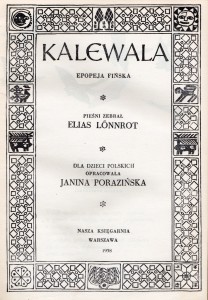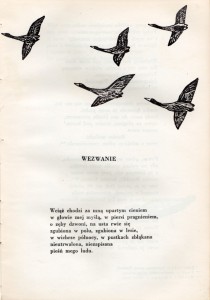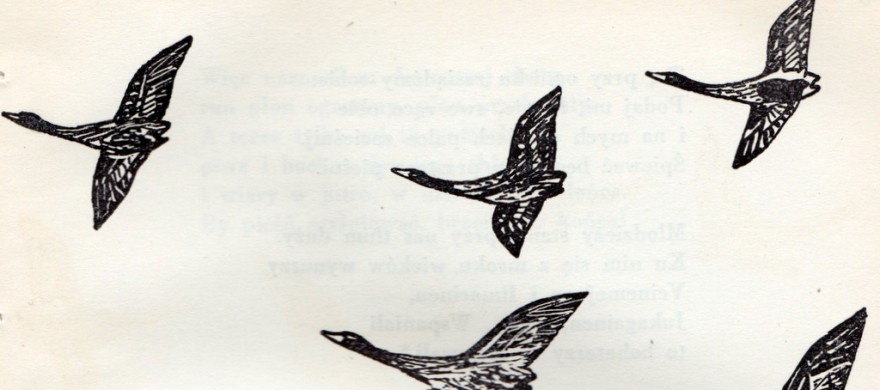After the first world war
Maria Karhelska, who was the first teacher of the Polish language at the University of Helsinki, published translations of different poems in the Kalevala during the time period between the two world wars. In 1925 the journal Przegląd Warszawski published the 1st poem and two years later the 41st poem came out in Gazeta Literacka. These were the first texts ever that were translated directly from the Finish language into Polish. In 1928 the translation of the 9th poem by Kazimiera Zawistowicz was published in the magazine Czas and in 1929 the journal Wiedza i Życie published a summary of the epic and three short lyrical parts of the 4th poem.

Janina Porazińska made a translation of the Kalevala tale for children, which was published in 1958. Michal Bylina illustrated the book.
 The debate both about Finland and its cultural heritage became more active in connection with the 100th anniversary of the Kalevala. In his article, K. A. Jaworski discussed the plot and the role of the epic and the uniqueness of its structure, which is a topic that has not been discussed that often. The article contained a partial translation of the 49th poem, which was done based on J. Belskij’s Russian translation. Jarowski, himself, called it some sort of Polish modification. Jan Brzechwa utilised the Russian translation as well. In the same year, the journal Kurier Poranny published excerpts of the 11th poem and the magazine Bluszcz published the 8th poem. During the Jubilee the journal Przegląd Polsko-Fińsko-Estoński also published an excerpt of J. Brzechwa’s translation of the Kalevala. It was claimed in the journal that this translation was the first translation of the Finnish epic. This either shows that the editors did not know the facts or that the earlier translations were of very little significance.
The debate both about Finland and its cultural heritage became more active in connection with the 100th anniversary of the Kalevala. In his article, K. A. Jaworski discussed the plot and the role of the epic and the uniqueness of its structure, which is a topic that has not been discussed that often. The article contained a partial translation of the 49th poem, which was done based on J. Belskij’s Russian translation. Jarowski, himself, called it some sort of Polish modification. Jan Brzechwa utilised the Russian translation as well. In the same year, the journal Kurier Poranny published excerpts of the 11th poem and the magazine Bluszcz published the 8th poem. During the Jubilee the journal Przegląd Polsko-Fińsko-Estoński also published an excerpt of J. Brzechwa’s translation of the Kalevala. It was claimed in the journal that this translation was the first translation of the Finnish epic. This either shows that the editors did not know the facts or that the earlier translations were of very little significance.
The translations by Brzechwa were re-published a few times in newspapers also in the Polish republic in connection to anniversaries and other important events in Finland. Furthermore, they are included in two collections by Brzechwa. Wiersze Wybrane (in English: A selection of poems) from 1955 and Liryki Życia Mojego (in English: The poems of my life) from 1968.
Brzechwa’s monopoly on the Kalevala was challenged by M. Krachelska-Tołwińska in 1948 when the Zeszyty Wrocławskie published 21 poems that she had translated. This was probably the first post-war attempt to translate the Kalevala. Nevertheless, it is important to note that until then all translations had been only of single songs. The original poetic form was usually not preserved and sometimes even the plot had been changed. Often a comment was added to the poem and the plot of the epic was presented to the readers as short summaries.
Besides these translations, two new translations came out as independent books. Janina Porazińska created an imaginary tale for children based on the Russian translation. The most important events in the Kalevala were included in the plot, but otherwise the book did not bear much resemblance to the original form of the epic. Michal Bylina illustrated parts of the book, which was published twice, in 1958 and 1967.
Józef Ozga Michalski approached this in a completely different manner. His translations of the poems were based on a philological translation by Karol Laszeckin and they were for 25 years the most complete original work of Finnish culture in Polish. Michal Bylin did the illustrations and the comprehensive descriptive section was written by M. and J. Bańczerowscy, two philologists from Poznan. This was the first complete Polish translation of the Kalevala and it has also been published twice, in 1974 and 1980 and it was received with great enthusiasm, both in the literary circles and in newspapers.
However, the enthusiasm and the positive reviews were put into new light when the translation by J. Litwiniuk came out in 1998. Litwiniuk, who was one of the most notable Polish translators of Finno-Ugric literature, had translated Suomalainen mytologia (Finnish mythology) in 1979. In his translation of the Kalevala, he did not only consider the Finnish spelling and grammatic, but he also utilised his knowledge of the cultural context, which was totally overlooked in the earlier translations. The version by Litwiniuk puts Olga Michalski’s translation in the same category as all the other previous ones, among the historical and philological curiosities, as we view these from today’s perspective. When we compare Litwiniuk’s translation to previous translations, it is easy to see their shortcomings. Litwiniuk, himself, mentions his predecessors only briefly when he discusses the history of the Polish translations and the problems with these that the earlier translators had to face.
When the reader compares the two translations, he/she may note differences, not only in the plot, but also in how much the Finnish epic tale differs from everything else that has been translated into Polish. A comparison of the translations by Litwiniuk and Ozga Michalski shows how important it is to know the historical and cultural context when translating texts. You cannot find this in the version by Ozga Michalski. Łukasz Sommer has analysed the problems in connection with the lexical issues as well as issues that have to do with the content and ethnological details in Michalski’s translation. One of the biggest mistakes is the intense accentuation of the separation of soul and body of the main characters. Another problem is the division into external and internal dichotomy, something that did not exist in the pre-Christian world of the Kalevala. The inconsistencies in the story are also interesting, as for example, leaving out the character Virokannas and calling the “old man” that baptised the son of Marjatta Väinämöinen, in other words, the same person that a moment earlier had sentenced Marjatta’s son to death. Sommer states that the version by Ozga Michalski is a paraphrase (in other words, an explanatory version) instead of a direct translation. The previous translations were, without doubt, paraphrases and even further away from the original text, but they played a part in the creation of the translation by Litwiniuk, which is regarded as the most important one today. These translations also depict the time period when they were done very well.
Anna Walkowiak: “Kalevala puolalais-suomalaisten kulttuurikontaktien lähteenä 1800-luvulla”. Kalevala maailmalla. Helsinki: SKS. 2012.
